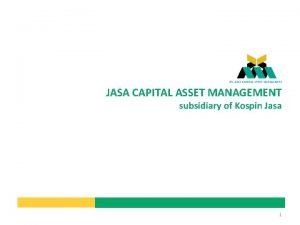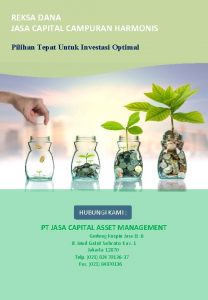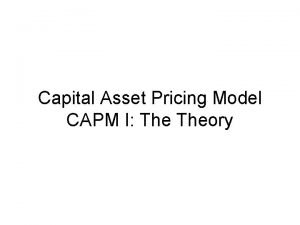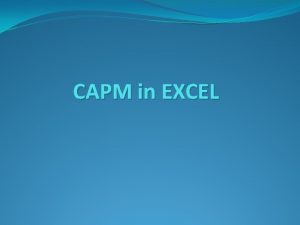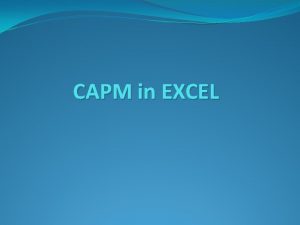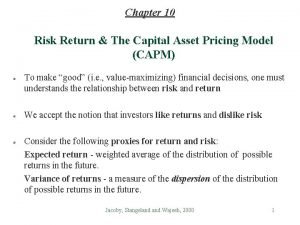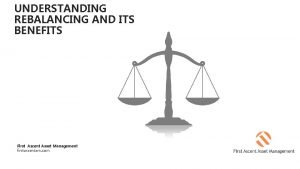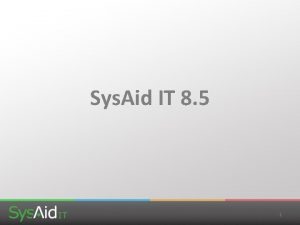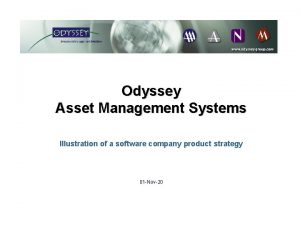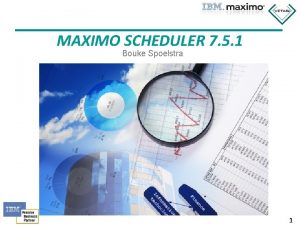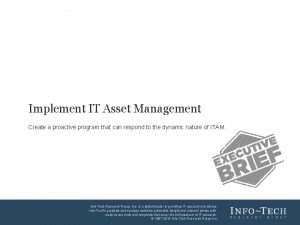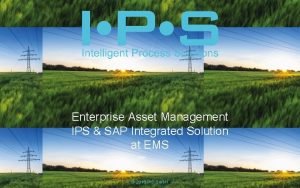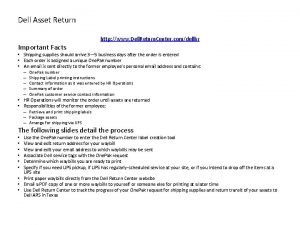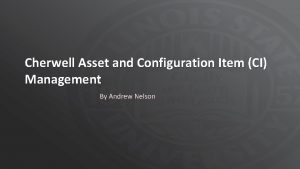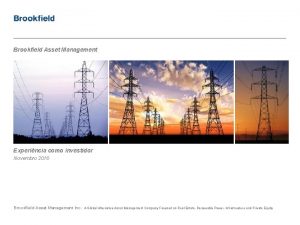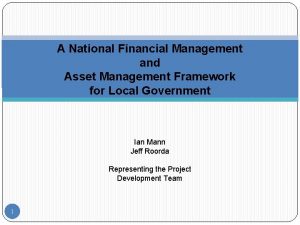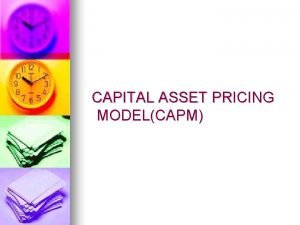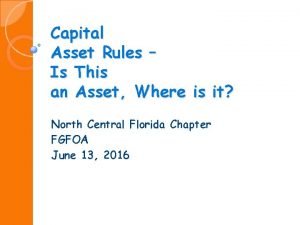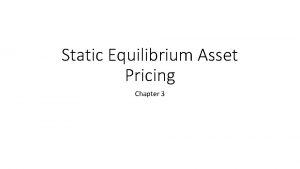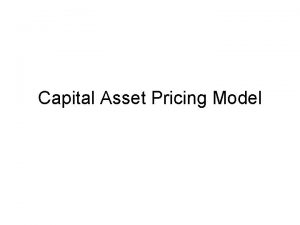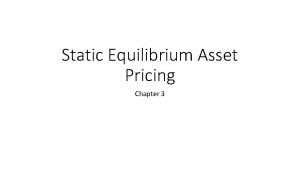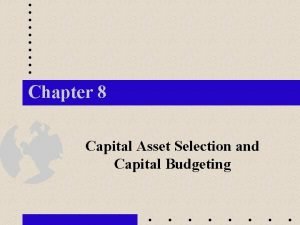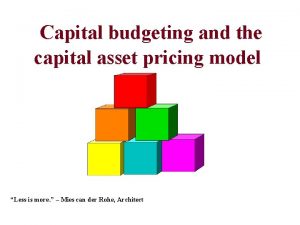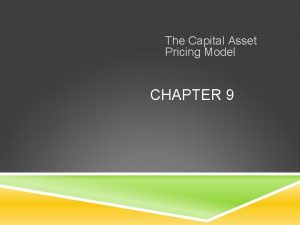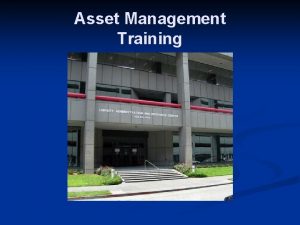Asset management infrastructure management Infrastructure management Capital management









































- Slides: 41

Asset management = infrastructure management Infrastructure management = Capital management = Asset management The differences between these terms are only slight. The engineer might favor “infrastructure management, ” the budget officer “capital management, ” and the accountant “asset management. ” 1

Asset management as a concept From the many uses of the term, it is easy to get confused about asset management, which has only recently been applied to infrastructure. In the past, asset management meant control of money and investments in the financial world, whereas currently, for infrastructure, it includes everything that is done, from cradle to grave, to derive the most value from a physical or fixed asset 2

Asset management as a concept Activities include the full life cycle of management: acquisition, construction, maintenance, renewal, and final disposal or replacement. 3

Asset management as a concept Operations should be part of asset management as well, because the way a facility is operated affects its lifecycle value. In infrastructure management systems, however, the emphasis is on capital, though some operational applications are now being reported. The focus in asset management on finance occurs because the main obstacle to infrastructure integrity is having enough money to invest in it and manage it. 4

Asset management as a concept The application of asset management to infrastructure places the focus on return-on-investment. It does not introduce new tools as much as it organizes existing ones and links uses of information for different functions. Infrastructure assets have always been there, but the public nature of financial accounting for them has inhibited the use of the term “asset management” until recently. 5

Asset management Definitions of asset management CartéGraph Systems wrote: “Public works asset management…is a combination of tools and procedures to enhance the inventory, management and maintenance responsibilities of a public works organization, ” and “public works asset management can most commonly be described as the daily practice of collecting, maintaining and analyzing this asset data. ” This definition emphasizes the data and software aspects of asset management. 6

Asset management activities Asset management involves five main activities, as shown in Table 3. 1. Each activity would normally focus on a separate area, but the information used in it would be shared by other management areas. Each organization will be different, of course, but one way to organize these activities would be as shown on Figure 3. 1. 7

Asset management activities 8

Asset management activities 9

Asset management activities 10

Capital improvement planning, programming, and budgeting Introduction 11

Capital improvement planning, programming, and budgeting Introduction 12

Capital improvement planning, programming, and budgeting Planning process In a water, wastewater, or storm water utility, planning precedes design by studying facility needs. Although it should be continuous, planning may not occur until a specific event requires it, such as growth, obsolescence, regulatory controls, or a failure. Priority then goes up and the governing board asks staff to prepare plans for a particular problem. 13

Capital improvement planning, programming, and budgeting Planning process 14

Capital improvement planning, programming, and budgeting Planning process In rational problem solving, the standard overall process is to recognize the problem, set goals, find options, evaluate them, choose a course of action, and implement it. These steps involve data collection, studies, approvals, presentations, and many other tasks. 15

Capital improvement planning, programming, and budgeting Planning process The political process enters at each step and raises questions such as: Whose problem is it? Who are the stakeholders? What is their stake and influence? What are the seen and unseen obstacles? How do we navigate the minefield of public opinion to win approval? What coalitions can be gathered to increase chances? and so on. 16

Capital improvement planning, programming, and budgeting Planning process Recognizing the problem and determining the need for water, sewer, and storm water systems means detecting the need for changes in capital facilities due to growth, obsolescence, condition, regulatory controls, or increasing reliability or service. 17

Capital improvement planning, programming, and budgeting Planning process Setting goals requires the balancing of supply and demand for the systems, while considering realistic scenarios for fund availability, growth, regulations, and other system drivers. 18

Capital improvement planning, programming, and budgeting Planning process Finding options is a creative process requiring information, knowledge, and experience with the systems. Finding options may also involve regional stakeholders who will partner with your system. 19

Capital improvement planning, programming, and budgeting Planning process Evaluating options requires the assessment of feasibility from technical, financial, social, political, legal, environmental, and managerial points of view. Evaluation is the stage at which analytical tools such as models, benefit– cost analysis, public involvement, sensitivity analysis, and other such tools are used. Project options must be screened systematically, and the procedure used to eliminate options must be documented. 20

Capital improvement planning, programming, and budgeting Planning process Implementing the plan may involve steps that go beyond the early stages of planning. New obstacles and possibilities sometimes occur in implementation, opening the way for applying “adaptive management” — adapting to the new situation or information. 21

Capital improvement planning, programming, and budgeting From integrated plans to capital improvement programs Infrastructure systems require valid plans that flow from general integrated plans to more specific capital plans for categories and sectors. Thus, an important aspect of the CIP process is the link between a capital project and the integrated plan, whether the systems involved are water, sewer, and storm water or other categories of infrastructure. . 22

Capital improvement planning, programming, and budgeting From integrated plans to capital improvement programs An integrated plan considers links of infrastructure with planning objectives such as urban development and land use. Integrated plans are called “comprehensive plans” and “policy plans, ” and are also known by names such as “Designing Tomorrow Today” or “Vision 2001 for the Metropolis. ” Generally, they outline goals and strategies for broad jurisdictions, and assess what must be done to achieve them. One might call these “framework” or “scoping” plans that include regulatory implications by setting goals for urban 23 design.

Capital improvement planning, programming, and budgeting From integrated plans to capital improvement programs Facilities or infrastructure plans must be translated into specific plans and programs. This requires a shift from the planning world to the engineering and financial worlds. In other words, integrated plans often do not carry any commitments, but once inside the engineering and financial worlds, the likelihood of implementation rises. 24

Capital improvement planning, programming, and budgeting Capital improvement programs Shifting from planning to programming involves an increase in commitment. Think of any plan as a document or a report about the feasibility of a concept. There can be many plans before a commitment is made. Some refer to plans as “shelf art” because there can be so many of them on the shelf. 25

Capital improvement planning, programming, and budgeting Capital improvement programs Once a project is listed in a “program, ” however, it implies that a commitment has been made to move ahead with it, including financing. Thus the capital improvement program is normally only published once definite decisions have been made to undertake projects in future years. These decisions may include a vote by a governing board or city council. 26

Capital improvement planning, programming, and budgeting Capital improvement programs Getting a planned facility onto a capital improvement program is actually one step in the bureaucratic struggle over budget politics. In the budget process, if one gets a project on an official or approved list, there may be a better chance of being funded than if it is not on the list. Thus, departments strive to get their projects on the “approved” capital programs list of an organization. 27

Capital improvement planning, programming, and budgeting Capital improvement programs A capital improvement program is, in the final analysis, a list of projects that an entity intends to implement under favorable circumstances. The uncertainty is about the intent and the ultimate capability to follow through with the intent. 28

Capital improvement planning, programming, and budgeting Water supply capital planning Water system plans include facilities for purposes such as these: • Growth — providing water supply to new areas • Obsolescence — replacing old, undersized pipes • Condition — renewing areas where pipes have deteriorated • Regulatory controls — upgrading to meet stricter water supply rules • Increase in reliability or service — spending to increase security 29

Capital improvement planning, programming, and budgeting Water supply capital planning Planning for water supply is driven by demand, flow rates, location of demands, and required quality of supplies. Estimates used to plan systems are normally based on per -capita consumption, peak demands, and fire flows. 30

Capital improvement planning, programming, and budgeting Water supply capital planning 31

Capital improvement planning, programming, and budgeting Wastewater system planning Examples of wastewater facilities planning include the following: • Growth — extension of gravity service to new areas • Obsolescence — replacement of outdated pipes or equipment • Condition — correcting an infiltration or inflow problem • Regulatory controls — upgrading a combined sewer overflow facility • Increase in reliability or service — solving backup or capacity problems 32

Capital improvement planning, programming, and budgeting Wastewater system planning for collection, treatment, and disposal starts where water supply leaves off and is driven by service demands and regulatory controls. Collection systems are planned to handle inputs to the system, treatment is planned to meet regulations, and disposal systems are planned to discharge liquid effluents and dispose of sludge residuals. 33

Capital improvement planning, programming, and budgeting Wastewater system planning Whereas water supply can deal with positive aesthetics, wastewater planning deals with external effects that include negatives such as odor and image problems. Additionally, wastewater treatment and disposal systems are downstream of cities rather than upstream. 34

Capital improvement planning, programming, and budgeting Storm water system planning Capital facilities for storm water have increased in importance with urbanization, flood problems, and non-point pollution. Examples of planning for storm water include the following: • Growth — provision of storm water to newly developed areas • Obsolescence — replacement of older, undersized systems • Condition — replacement of deteriorated storm water systems • Regulatory controls — expenditures to meet new state mandates • Increase in reliability or service — upgrading systems for bigger storms 35

Capital improvement planning, programming, and budgeting Storm water system planning Storm water systems are closely related to land use, and may involve multidisciplinary teams more than water supply or wastewater systems do. For example, in a new development, the storm water system may involve underground piping to drain streets, green strips as parkways and recreation areas, ponds to detain runoff and improve water quality, and other aesthetic enhancements. Thus, planning for storm water takes on a somewhat different character from that 36 of water or sewer.

Capital improvement planning, programming, and budgeting Evaluation techniques and priority-setting In choosing water, sewer, and storm water investments, multiple criteria must be applied because the problem requires multi-criteria decision analysis (MCDA). The types of criteria to apply are the following: 37

Capital improvement planning, programming, and budgeting Evaluation techniques and priority-setting • Technological — does the plan promise to meet goals effectively? • Legal — is the plan legal and does it pass a test of legal feasibility? • Political — is the plan politically feasible? • Institutional — can the owner implement the plan in the long term? • Financial — does the plan have an acceptable rate of return? • Risk and vulnerability — does the plan bring unacceptable risk and vulnerability? • Social — to what extent are people impacted negatively? • Environmental — does the plan introduce negative environmental consequences? • Economic — does it pass a benefit–cost test? 38

Capital improvement planning, programming, and budgeting Evaluation techniques and priority-setting These criteria may seem daunting, but they are all applicable and a good plan will consider all of them. Notice that the criteria involve both quantitative measures and non-quantitative measures. It would be convenient if plans could be reduced to just numbers, but public decisions involve many issues that are not amenable to numerical comparisons. 39

40

41
 Managing assets vs asset management
Managing assets vs asset management Jasa capital asset management
Jasa capital asset management Jasa capital asset management
Jasa capital asset management Working capital financing approaches
Working capital financing approaches Arbitrage pricing theory formula
Arbitrage pricing theory formula Capm xls
Capm xls Capm on excel
Capm on excel Calculate expected portfolio return
Calculate expected portfolio return Human capital intangible asset
Human capital intangible asset Capital allocation between risky and risk free asset
Capital allocation between risky and risk free asset Working capital introduction
Working capital introduction Source of capital reserve
Source of capital reserve Multinational cost of capital and capital structure
Multinational cost of capital and capital structure Difference between capital reserve and reserve capital
Difference between capital reserve and reserve capital Basle ii
Basle ii Regulatory capital vs economic capital
Regulatory capital vs economic capital Constant capital and variable capital
Constant capital and variable capital Multinational cost of capital and capital structure
Multinational cost of capital and capital structure Capital allocation line vs capital market line
Capital allocation line vs capital market line Managing assets vs asset management
Managing assets vs asset management First ascent asset management
First ascent asset management Maximo dynamic job plans
Maximo dynamic job plans Social media for asset managers
Social media for asset managers Unity asset management
Unity asset management Sysaid it asset management
Sysaid it asset management Roof asset management software
Roof asset management software Pensum forsikringsmegling
Pensum forsikringsmegling Oracle enterprise asset management
Oracle enterprise asset management Odyssey asset management
Odyssey asset management Ibm maximo scheduler
Ibm maximo scheduler Premier asset management and maintenance
Premier asset management and maintenance It asset management sop
It asset management sop Ipssap
Ipssap Dell waybill
Dell waybill Cherwell inventory management
Cherwell inventory management Who owns brookfield asset management
Who owns brookfield asset management Automate asset management
Automate asset management National asset management assessment framework
National asset management assessment framework Software asset management microsoft
Software asset management microsoft Ranked vulnerability risk worksheet
Ranked vulnerability risk worksheet Lawrence park credit strategies fund
Lawrence park credit strategies fund Industrial asset management llc
Industrial asset management llc

